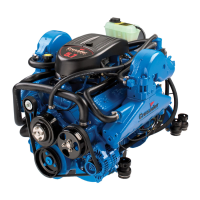51
L510023-07
3. Propeller Identifi cation and Inspection
(Refer to the Crusader Owner’s Operation and Maintenance Manual and the
Crusader Master Engine Specifi cation Sheet for operational parameters based on
propeller selection.)
• Proper boat performance is dependent upon boat design, engine power
and a properly sized propeller. The size markings will be needed if a
performance issue is raised.
• Prior to installation of the propellers, locate the size and rotation markings on
the propeller(s).
• Record the markings, Diameter, Pitch, and Rotation in the space provided
and compare to known standards. If you are unsure of the proper propeller
size, contact the boat manufacturer for the information necessary to
determine the proper size for the boat. Correct any defi ciency.
Diameter:
Pitch:
Rotation:
NOTICE: The boat manufacturer and/or the dealer selects and installs
the propeller(s). Problems that are associated with the propeller(s) or its
installation should be corrected at the direction of the boat manufacturer
and/or installer and are not a Crusader Warranty item.
4. Static Leak Check of Fuel and Oil Lines
Check all fuel and oil lines for leaks. Using your hand check each and every
fuel line and oil line to and on the engine for leaks. Note the location of any
leaks found. Correct any defi ciency. Check the compliance box.
NOTICE: The boat manufacturer and/or the dealer selects and installs the
fuel lines from the fuel tank to the engine. Problems associated with this
fuel line or its installation should be corrected at the direction of the boat
manufacturer and/or installer and are not a Crusader Warranty item.
5. Engine Wiring Inspection
Do a visual inspection to insure that all plug-in connectors of the engine wiring
harness are plugged into their proper devices. Check to insure that the boat
harness is plugged completely and correctly into the engine harness. Correct
any defi ciencies found and check the compliance box.
6. Static, Prelaunch Fluids Check
• Engine and transmission oil levels must be verifi ed prior to engine operation.
These levels will again be checked after operation. Normal levels for both
the engine and transmission should be between the Low and Full marks on
the dipstick. Oil levels must be at least to the low oil level mark at this
time.
• With the boat resting close to its in-the-water position, remove the engine(s)
dipstick(s) and wipe the dipstick(s) clean of oil and insert the dipstick into the
dipstick tube. Be sure that the dipstick bottoms out in the tube.
• Remove the dipstick and note the oil level. Correct any defi ciency for each
engine.
• Remove the dipstick from each transmission, wipe the dipstick clean of oil
and insert the dipstick into the dipstick opening. Be sure that the dipstick
bottoms out on case (Velvet Drive) or to the threads (Hurth - Note: do not
screw the dipstick in when checking fl uid levels.).
• Remove the dipstick from the transmission and note the oil level. Correct
any defi ciency. NOTE: Oil levels slightly above the full mark, at this
time, would be normal. Do Not remove fl uid at this time.
PORT STBD
PORT STBD
PORT STBD
PORT STBD

